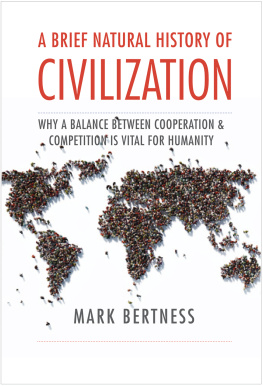Nature Strange and Beautiful
Nature Strange and Beautiful
How Living Beings Evolved and Made the Earth a Home
Egbert Giles Leigh, Jr.
Christian Ziegler

Published with assistance from the foundation established in memory of Calvin Chapin of the Class of 1788, Yale College.
Text copyright 2019 by the Smithsonian Institution.
Photos taken by Christian Ziegler copyright 2019 by Christian Ziegler.
All rights reserved.
This book may not be reproduced, in whole or in part, including illustrations, in any form (beyond that copying permitted by Sections 107 and 108 of the U.S. Copyright Law and except by reviewers for the public press), without written permission from the publishers.
Yale University Press, in association with the Smithsonian Tropical Research Institute.
Yale University Press books may be purchased in quantity for educational, business, or promotional use. For information, please e-mail (U.K. office).
Set in Bulmer type by Tseng Information Systems, Inc.
Printed in the United States of America.
ISBN 978-0-300-24462-5 (hardcover : alk. paper)
Library of Congress Control Number: 2019931653
A catalogue record for this book is available from the British Library.
This paper meets the requirements of ANSI/NISO Z 39.48-1992 (Permanence of Paper).
10 9 8 7 6 5 4 3 2 1
Contents
Preface
THE IDEA OF EVOLUTION BY NATURAL selection can heighten our appreciation of the beauty of nature. The French mystic Simone Weil believed that the true definition (and proper function) of science is the study of the beauty of the world; this book accordingly tries to show how evolutionary thinking can help us appreciate this beauty. We supply compelling evidence that the worlds plants, animals, and microbes evolved and diversified from common microbial ancestors in response to natural selection: evolution by natural selection is indeed an appropriate lens for studying this beauty. To communicate this beauty, however, requires not only a scientist, but gifted artists and talented photographers, such as Christian Ziegler, the creator of so many of the stunning photographs in this book.
Thus we focus on the beauty and strangeness of nature, the unexpected steps and curious mechanisms by which the natural world we find so beautiful came to be. A steady energy subsidy through a crack in the sea bottom, in the floor separating the ocean from the volcanically turbulent underworld below, enabled beings that harnessed this energy to reproduce themselves, to arise from non-living processes through the coordination of a host of chemical reactions. Descendants of these multiplying beings transformed the geology near the earths surface and took the first steps toward making the earth a suitable home for life. More than 500 million years ago, consumers of living beings appeared in an unprepared world, prompting an ever growing number of both predators and the algae- or detritus-eaters they preyed upon to evolve ever improving awareness of, coordinated with continually improving responsiveness to, events in their surroundings. This awareness was part of the foundation for the evolution of human minds. Indeed, habits evolved for one purpose sometimes have far-reaching consequences in startlingly different realms. Play presumably evolved in mammals, especially social mammals, as exercise in activities requiring close coordination between eye, mouth, and foot, and as practice among playfellows in social relations. In some animals, play became a form of disinterested exploration of their worlds, learning for learnings sake. Science and art are forms of play that, in the right hands, attained the immaterial truths of mathematics and the glorious achievements of Dantes Commedia, Einsteins general theory of relativity, and Paul Diracs quantum mechanics. A sense of beauty drove all these achievements, which in turn enhanced our appreciation of the beauty of the world.
Natural selection is competition. Yet in the natural world, as in human economies, organisms cooperate to compete better with third parties, as the economist Adam Smith was the first to show. Thus a tropical forest, like a modern human economy, is both an arena of intense competition and an acme of interdependence and cooperation. As Smith also argued, rules of fairness must be enforced if competition is to serve the common good. Thus Platos dictumthat a gang of thieves is effective only if its members treat each other justlyhelps us see why an animals (notoriously selfish!) genes collectively enforce rules ensuring that a gene spreads only if it benefits the individuals that carry it. More generally, the ways animals in a cooperative group prevent cheating that undermines all the good of cooperating sheds light on why cancerous cell lines so rarely spread and kill the animals they belong to. Indeed, the analogy between maintaining cooperation within the company of an animals cells and maintaining cooperation in the company of bees in a honeybee hive has shed light on how activities of an animals cells, and a hives honeybees, are coordinated. Similarly, the Dutch philosopher Spinozas dictum that our own self-interest requires that we benefit those who benefit us sheds light on how the great grazers of the Serengeti grasslands protect these grasslands by keeping trees out and enriching the grassland by manuring the grass appropriately, thus making these grasslands a better home for grazers.
Abundant experience of nature at its most beautifulespecially in the tropical forest of Barro Colorado Island in Panama, but also in Madagascar, Peru, and other tropical countries, as well as the rocky wave-beaten shores of Tatoosh, a cluster of islets off the northwest tip of the Olympic Peninsula in Washingtonis reflected in this book. It has been written and rewritten in an office on Barro Colorado, inspired by the music of Bach, Monteverdi, and many others. This book was written in collaboration with Christian Ziegler, who likewise is thoroughly familiar with Barro Colorado Island and nearby mainland in Panama, but who also has worked in the Democratic Republic of the Congo, northeast Australia, Borneo, Thailand, Bhutan, and many other exotic sites. This book is a counterpart about evolution to A Magic Web, a book about the ecology and natural history of Barro Colorado that Christian and I collaborated on some years ago. By working together once again, we hope this book will help to show how understanding evolution reveals the beauty of nature.
Acknowledgments
FIRST AND FOREMOST, WE ARE MOST grateful to the artists and other photographers who contributed to this book. The contributing artists are Debby Cotter Kaspari, Damond Kyllo, Anne Klein, Barrett Klein, Mary Bruce Leigh, Aaron ODea, and Danielle VanBrabant; the contributing photographers, Anne Paine, Robert Delfs, Janie Wulff, Annette Aiello, Patrick Kennedy, and Teague OMara. Next, we heartily thank those who read successive drafts of the whole manuscript: Anthony Coates, Henry Horn, and Richard Schooley. Janie Wulff provided helpful comments on parts of the book. Various schoolteachers visiting Barro Colorado from the Professional Resources Institute for Science and Mathematics, Montclair State University, New Jersey, read the chapter on heredity and natural selection about elementary genetics, and declared it readable (when it was still devoid of illustration!). Christie Henry, formerly with the University of Chicago Press, provided remarkably helpful and constructive advice while the work was still in progress. Karen Kostyal greatly improved the beginning of the book, especially the section on the origin of life. Finally, I am deeply indebted to Geerat Vermeij, with whom I have discussed the problems of evolutionary biology so often that it is difficult to discern whose idea was whose. His astounding command of the literature has plugged many a gaping hole in my knowledge.
Next page











